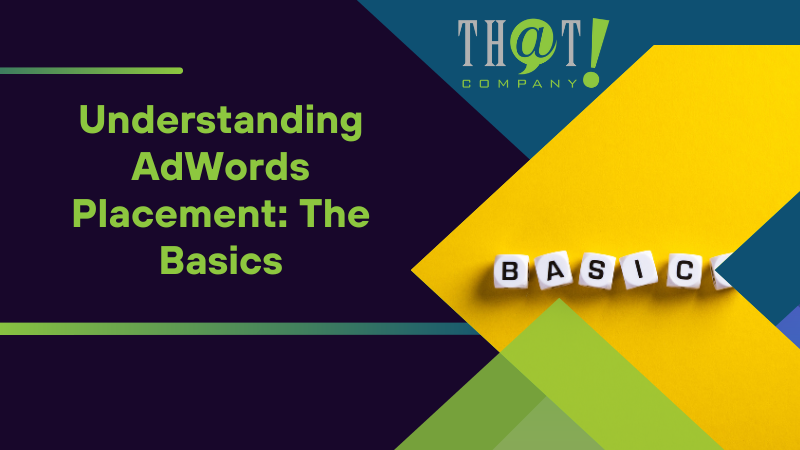
Wondering how to master AdWords placement (Now Google Ads) for optimal online visibility? Placing your ads correctly is crucial for driving sales and enhancing your ad spend ROI. This guide offers actionable insights into strategic ad placement on Google, underlining its importance and giving a sneak peek into the targeted strategies that await. Get ready to position your ads for peak performance without breaking the bank.
Key Takeaways
- AdWords placement is critical for reaching the right audience effectively by selecting specific websites, apps, or channels and aligning ads with relevant content through methods like managed placements, keyword targeting, and topic targeting.
- White label PPC services, such as those offered by That! Company, provide benefits to agencies including expertise, cost savings, improved efficiency, and the ability to offer a broader range of digital marketing services.
- Effective AdWords strategy includes analyzing and optimizing ad placements using Google Analytics, considering ad formats’ impact on performance, and employing best practices such as testing placements, monitoring audience demographics, and using tools like Customer Match for targeted campaigns.
Understanding AdWords Placement: The Basics

AdWords placement is a game of strategy – choosing the right place at the right time for your ads to shine. Whether it’s on specific websites, apps, or channels for ad display, the goal is to reach your target audience in the most effective way. It’s about complementing your ads with other targeting methods such as topics or keywords to ensure they appear on content that matches your targeting criteria.
The power of AdWords placement extends beyond just positioning your ads. It’s about strategic alignment – ensuring that your ads are placed where they will have the most impact, thereby maximizing your return on investment (ROI). Picture this: your ad appearing on a site that your target audience frequently visits. This isn’t just about reaching more people; it’s about reaching the right people.
What is AdWords Placement?
AdWords placement is all about location. It’s the strategic process of selecting specific websites, apps, or channels where your ads will be displayed, ensuring they reach your target audience. It’s not just about displaying your ads on any website but choosing placements that make sense for your brand and your audience. These placements can be as broad as entire websites or as targeted as specific pages within websites.
But it’s not just about the where; it’s also about the what and the how. AdWords placement goes beyond webpages to include:
- individual ad units on a page
- videos
- mobile apps
- and more
This allows for a more diverse and dynamic ad display, increasing the chances of effectively reaching your intended audience through a well-planned display campaign.
Why is AdWords Placement Important?
The importance of strategic ad placement cannot be overstated. It’s the vehicle that drives your ads to the right audience, leading to successful marketing outcomes. More importantly, it plays a significant role in increasing brand visibility and maximizing return on investment. After all, what’s the point of having a beautifully designed ad if it’s not seen by the right people?
Proper AdWords placement is like a compass that directs your ad towards success. By utilizing tools like Google Analytics, you can review ad placements, identify which ones are successful, and refine your targeting strategies accordingly. It’s also essential to keep a close eye on significant changes in ad spend and address budget-related fluctuations to enhance overall ad performance.
The Google Ads Agency That Other Google Ads Agencies Use
When it comes to managing Google Ads, agencies often turn to That! Company. Known for its extensive knowledge and successful track record, That! Company provides white label Google Ads Management services specifically tailored for other agencies.
Collaborating with That! Company allows agencies to:
- Leverage the expertise of seasoned professionals
- Navigate the complexities of AdWords placement
- Focus on what they do best
- Provide their clients with top-notch Google Ads services
Benefits of White Label PPC Services
White label PPC services offer a multitude of benefits, including:
- Reducing costs by minimizing the need for in-house PPC campaign management and associated expenses like software and staff training
- Allowing agencies to focus more on their core marketing strategies, such as SEO or social media
- Improving operational efficiency
The flexibility and scalability of white label PPC services are also worth noting. These services allow agencies to easily adjust their offerings to meet business demands and growth without overextending resources. What’s more, expert PPC managers from white label services constantly monitor and fine-tune campaigns to ensure high levels of performance. This not only contributes to client satisfaction but also helps build long-term partnerships.
And that’s not all. White label PPC services transform agencies into one-stop solutions for digital marketing, giving them a competitive edge in the marketplace. By leveraging these services, an agency can increase its offerings and market impact without the need for additional personnel, driving business growth.
Strategies for Effective AdWords Placement

Efficient ad placement is an art that requires a strategic approach. As such, there are three key strategies you can adopt for effective AdWords placement – managed placements, keyword targeting, and topic targeting. These strategies ensure your ads appear on relevant content, increasing the chances of reaching your target audience.
Understanding the Google Display Network is also essential as it is the platform that places your ads on various websites, apps, and channels to reach your target audiences. By monitoring ad performance on this ad network, you can make informed bid adjustments, optimizing your campaign results.
This, combined with the practice of analyzing performance metrics such as conversion rate, cost-per-acquisition, and return on ad spend, can help you adjust your individual placement bids accordingly, optimizing your placements.
Managed Placements
Managed placements offer a level of control that can be a game-changer in your AdWords strategy. With this method, you have the power to choose the specific websites, apps, or channels for your ads. This means you can ensure your ads are placed on platforms where your target audience is most likely to engage with them.
For instance, if your company develops mobile games or apps, selecting mobile as a targeted placement for your ads ensures relevance and promotes user engagement. Considering where your target audience is most likely to use your product also impacts user experience and can guide whether to include or exclude certain devices.
Keyword Targeting
Keyword targeting is another effective strategy for AdWords placement. The Google Display Network offers affordability and a broad reach, making it an attractive platform for keyword-targeted ad placement. Unlike traditional search ads that cast a wide net, the Google Display Network allows for more precise targeting while avoiding costly competition.
The primary goal of using the Google Display Network is to find an appropriately-sized audience through strict targeting criteria based on selected keywords. By utilizing Google Display Ads, this ensures your ads reach the right people at the right time, maximizing their effectiveness.
Topic Targeting
Topic targeting is the third key strategy for effective AdWords placement. With this method, your ads will appear on web pages related to specific topics or interests. This ensures that your ads align with the content that the users are interested in, increasing the chances of engagement and conversion.
The user’s primary interest on the Google Display Network is the website content itself. Therefore, aligning your ads with relevant topics is crucial. In-market segments on the Google Display Network reflect users’ interests in broad categories of products and services, a key element for refining topic targeting based on historical user behavior.
Ad Formats and Their Impact on AdWords Placement

The format of your ads can significantly impact their placement and overall performance. The three main types of ad formats on Google are static, animated, and interactive ads. Each format has its unique characteristics and offers different benefits.
The right ad size also plays a significant role in ad placement. For example, the Medium Rectangle format has the highest ad impression share on the Google Display Network, making it a reliable choice. The 336 x 280 large rectangle ad size has been observed to be particularly effective when positioned near the upper left-hand side of an article. This specific placement has been found to have a positive impact on engagement and click-through rates.
Static Ads
Static ads are the traditional, non-moving format that you see on various platforms, including display ads. They allow advertisers to use their own ad designs on the Google Display Network, offering a level of customization that can be beneficial for brands with a specific aesthetic or messaging.
However, as effective as static ads can be, they also have their drawbacks. One of the main issues is “banner blindness,” where users subconsciously ignore banner-like information. Thus, positioning static ads close to the primary content can lead to higher visibility, as ads in the center of the screen are more likely to be noticed.
Animated Ads
Animated ads, on the other hand, bring a dynamic element to your advertising. They are designed to capture the viewer’s attention through movement, making them more memorable than static ads. The use of motion in advertising can lead to higher ad recall, meaning viewers are more likely to remember your ads than static ones.
The creative use of transitions and animations in ads helps convey the message succinctly while keeping the viewer entertained. However, it’s crucial to ensure that animated ads are compatible with all devices and browsers to maximize reach and impact.
Interactive Ads
Interactive ads are where the fun really begins. These ads encourage users to engage in various ways, from clicking to swiping, which can lead to higher engagement rates compared to non-interactive formats. This action-oriented design results in higher click-through rates, as they prompt users to interact out of curiosity or interest.
Interactive ads, including video ads, allow for a more immersive experience. They can feature elements such as video carousels, mini-games, or data capture forms to provide an engaging user experience. This not only makes your ad more engaging but also fosters a stronger emotional connection with the audience.
Best Practices for AdWords Placement

Getting the most out of your AdWords placement involves mastering a few important best practices. These include identifying high-performing placements, testing and optimizing placements, and considering audience demographics and interests.
Reviewing potential placements before your ads go live is crucial for achieving your campaign goals and optimizing ad performance. Using Google Analytics and Google Ads can help you research and test new placement opportunities to maximize ad reach and effectiveness. Plus, adjusting bids for specific locations on the Google Display Network can optimize budget allocation, leading to increased profitability.
Identifying High-Performing Placements
Identification is the first step to optimization. Google Analytics allows advertisers to identify successful ad placements by analyzing performance fluctuations of ads, along with budget trends and times when budgets are most depleted.
Ad placements can be discovered by examining the Referrals report in Google Analytics. This identifies potential websites for ad display. Advertisers can find new google ad placements by searching for URLs from referral sources in Google Analytics when creating an ad group in their Google Ads account.
Testing and Optimizing Placements
Once you’ve identified potential placements, the next step is to test and optimize them. This can be done by monitoring ad placements in the ‘Where Ads Showed’ section in the Placements page of the Google Ads interface.
Optimization involves:
- Blocking duplicate or irrelevant placements that don’t yield results
- Assessing their relevance, expenditure, and conversion outcomes
- Ensuring that your ads are placed where they will have the most impact
Considering Audience Demographics and Interests
Lastly, it’s essential to consider your audience demographics and interests when placing your ads. Performance should be meticulously analyzed by assessing how different audience demographics and devices contribute to the campaign’s goals. This enables adjustments to bids and targeting settings to better focus on high-performing segments.
Advanced targeting features like Customer Match allow for precise ad delivery to groups based on email lists. This aligns your ads with the known preferences of specific individuals or similar audiences. Regular review of bid modifiers is also crucial to align and optimize ad targeting with evolving audience performance. For businesses looking to streamline their advertising efforts, partnering with a white label ad agency can provide specialized expertise and resources to maximize campaign effectiveness.

Conclusion
AdWords placement is a strategic tool that can significantly enhance your digital marketing efforts. By understanding what AdWords placement is, why it’s important, and how to choose an effective Google Ads agency, you can optimize your ad performance and maximize ROI. Incorporating strategies like managed placements, keyword targeting, and topic targeting, along with choosing the right ad formats, can ensure your ads reach the right audience. Finally, following best practices can help you identify high-performing placements, test and optimize them, and consider audience demographics and interests.

Commonly Asked Questions
What is AdWords placement?
AdWords placement involves selecting websites, apps, or channels for displaying ads to reach the target audience.
Why is AdWords placement important?
AdWords placement is important because it ensures your ads reach the right audience, boosts brand visibility, optimizes ad performance, and maximizes return on investment. It is crucial for successful advertising.
What are some effective strategies for AdWords placement?
Effective strategies for AdWords placement include managed placements, keyword targeting, and topic targeting. These methods help ensure your ads appear on relevant content, ultimately increasing your reach to the target audience.
How does ad format impact AdWords placement?
The format of your ads can significantly impact their placement and overall performance by influencing visibility and viewer engagement. Different ad formats like static, animated, and interactive ads offer varying benefits in AdWords placement.
What are some best practices for AdWords placement?
The best practices for AdWords placement include identifying high-performing placements, testing and optimizing them, and considering audience demographics and interests. This will help you maximize the effectiveness of your ads.






























